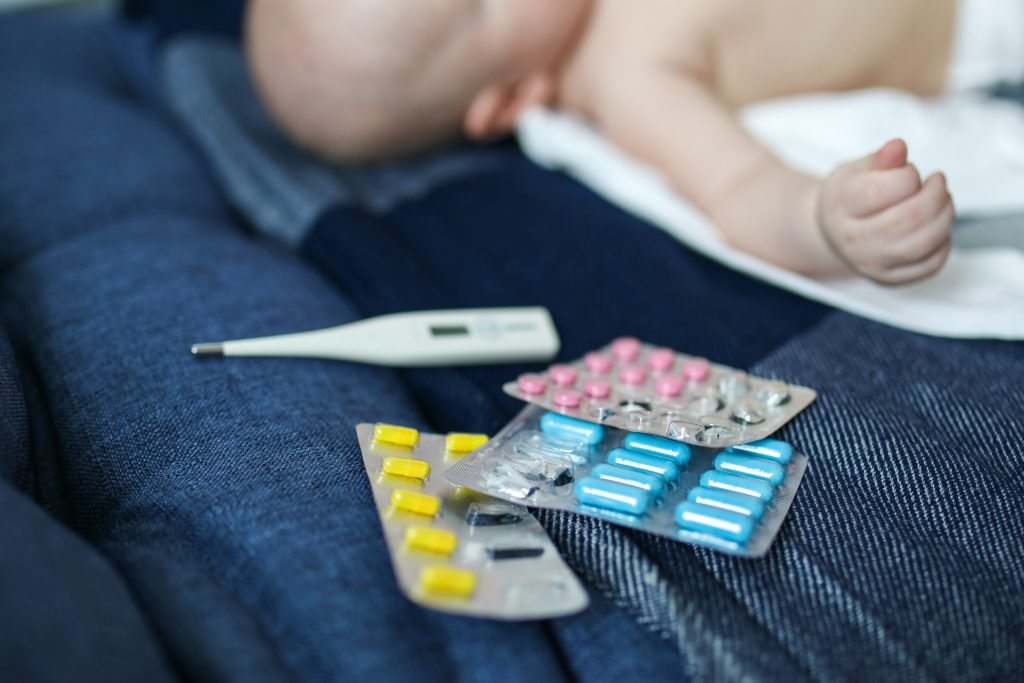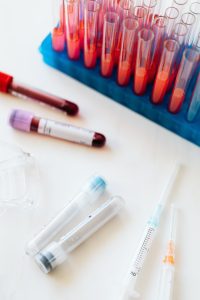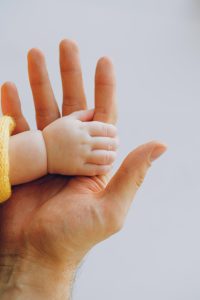*This is a very long post, but I am sharing this adventure in full detail with hopes of helping other parents find answers for their children much faster and easier than I did*
When my first child, G, was born in 2016, I was one year into my legal career and one year into my marriage. Her birth was traumatic—for her, for me, and for my husband. Soon afterwards, I was diagnosed with Hashimoto’s disease, post-partum depression, and post-partum anxiety. I was transitioning into a stay-at-home role, and my husband unexpectedly started a new career. To say life was “challenging” would be an understatement.
But in addition to these heavy changes, our sweet girl would not sleep lying down flat. If she wasn’t upright, she screamed. My husband would spend hours with her high on his shoulder, gently bouncing, shushing, swaying until she would finally fall asleep, too tired from crying to stay awake. She would also projectile vomit several times a day, each time until her stomach emptied, my breastmilk completely undigested. She would gag and choke while nursing, no matter the position we tried or how much milk I pumped out first. She ate noisily, and would unlatch often in an angry fit, arching her back and refusing to finish her feeding. She was often congested, her spit-up full of mucus and chunks of sour milk. I may have been a first-time mom, but I knew this could not be normal!
We took G to the pediatrician, who showed immediate concern over the possibility of pyloric stenosis. After gently pressing on her belly and carefully examining her, the doctor opted to try acid reflux medication first, and then if there was no improvement, we would investigate further. Thank GOD the acid reflux medication worked—the possibility of our newborn needing surgery was unfathomable.
By four months old, G was finally sleeping as a four-month-old should be, and she was no longer vomiting. However, she didn’t spit up frequently like most infants diagnosed with acid reflux. Her spit up was infrequent, but when she did, it was foul, green and yellow, and was obviously painful on its way up her throat. She was on Zantac every day, twice a day—her dose changing every two weeks with her weight gain. If we missed G’s dose by even an hour, we were quickly reminded by the sudden vomiting and screaming that ensued. It seemed, though, that as long we kept up with her medication, our little girl would be just fine.
Transitions and New Symptoms
At six months old, we introduced solid food in the form of purees. At first, she seemed to handle the new foods with ease. G loved to eat, and rarely turned anything down. We noticed some foods seemed to make her extremely gassy, so we decided to remove those foods for a week or two then try again. Eventually though, it seemed like everything gave her a stomachache. So, I decided to try and make my own baby food, hoping the thicker consistency and freshness would make a difference, but it made very little. Her pediatrician assured us some babies just have sensitive, immature digestive systems and it was normal for her to need more time to adjust. At this time too, I noticed our girl had developed colorless, raised patches of what felt like extremely dry skin all over body. Her pediatrician said it was mild eczema, and to treat it with Ceravé lotion. It didn’t help much at all, so I changed her bath and lotion products, thinking perhaps her skin was sensitive to the chemicals in them. Again, these changes proved to cause slight, if any, improvement.
But hey—she was still sleeping like a dream, and was still a relatively happy baby, as long her belly wasn’t hurting, or her reflux wasn’t acting up. And while she had developed these very pronounced, purple bags underneath her eyes, the doctor simply said it was the pollen in the air, and they would fade with time. I trusted this answer and figured we’ve all got our health “issues,” and these were hers. We could handle it.
When G turned eight months old, I found out we had another sweet baby on the way. While I tried to continue breastfeeding my oldest, I only made it another two months before I was forced to switch her to formula. I couldn’t take the painful sensitivity; each nursing session I would clench my jaw in pain, begging for her to hurry up. As upset as I was about weaning her, it was also a relief—or so I thought. Almost immediately upon the switch, she had developed a horrible, painful diaper rash. At first, I didn’t connect the formula with the diaper rash; I assumed it was just a normal occurrence. G had never had a diaper rash before, so I thought the red bumps and blistered skin came with the territory. But no matter how much diaper cream we applied the rash wouldn’t heal. By the time we took her to the pediatrician (maybe three days later), the rash had developed into open wounds that bled and caused her to cry with each bowel movement. The doctor sent us home with extra strength ointment, pain reliever, and orders to apply Mylanta or similar anti-acid medication to her bottom at every change.
While this helped the wounds heal, the rash never went away. We switched her formula twice, then finally decided to ditch the formula and go straight to cow’s milk. This turned out to be a HUGE mistake. The open wounds returned, and so did her reflux—full force vomiting and all. Under the guidance of her doctor, we upped her Zantac medication and switched her to soy milk. This combination seemed to work, and after about two months from the initial rash, her bottom had finally healed.
Most acid reflux babies can wean from medication by six months of age, but not G. She remained on Zantac until she was eighteen months old—six months past the recommended age to discontinue. Every time we tried to lower her dosage, her vomiting would ensue, and she would be unable to sleep. The only *magical* thing I can think of that happened at eighteen months old is that I removed the soy milk from her diet completely and decided to replace her calcium needs with foods like yogurt and cheese. I chose to remove soy from her diet after discovering it was a major migraine trigger for myself, and I was worried it could possibly cause inflammation in my daughter as well.
…Is this An Allergy?
As she moved into her toddler years, our oldest suffered from GI issues, continued reflux (but not severe enough to medicate), inexplicable rashes, constant sinus issues, an overall cranky + unpleasant attitude all of the time, and full-body, raised hives. The hives were the scariest symptom. They would start at her mouth, then cover her entire trunk and bottom. She would cry at how itchy they were, and they were hot to the touch. I knew this could be an allergic reaction—but like, how severe was this? I had never dealt with an allergy before, so I wasn’t sure what to do—do I call 911? Do I take her to the ER? No, she’s breathing just fine, so that’s not the right call—is it? I called the pediatrician and was told to give her Benadryl and to monitor her. G responded well to the Benadryl, and after a few days, I quickly dismissed the incident as a freak occurrence. She had just gotten over an upper respiratory infection a couple of weeks prior, and so, I reasoned, it’s possible it was a delayed reaction to the antibiotics, or potentially a viral bug going around, and her immune system was still weakened.
Until it happened again. And again. And again. In February of 2020, at three years old, I took G to an allergist who ordered labs. Of all the allergens we tested, not a single one was positive in her bloodwork. Of course, COVID-19 shut down everything the week we were due for an appointment to discuss our options, and we were left without answers, as his office was permanently closed. The best her pediatrician could offer was a virus, and “some kids just get hives.” After a few weeks, the hives faded and occurred less frequently. This assured us she must have just caught a strange viral infection, and there was nothing further we could do but treat the symptoms. Eventually, the hives stopped entirely, but G’s reflux, eczema, GI problems, and constant meltdowns continued to the point that it became our “normal,” and we thought this was just who G was as a child.
New Baby, Same Concerns
Fast-forward to December of 2020: our third baby girl, B, was a newborn at two months old, and our family of five had just recovered from COVID-19. B was a dream for those first two months—until the end of December when she stopped sleeping through the night completely. Every two hours, she would wake up hysterically crying, and nothing my husband or I did could soothe her. She would scream until she was purple; the kind of scream that causes your gut to lurch. She had started to arch her back when nursing and would have horrible stomach aches throughout the day and night. I kept calling the pediatrician after hours, asking, “at what point do I take her to the ER?” Only to be met with, “have you tried giving her a bath?”
This response made me feel dumb. Of course I had tried all of the tricks to calm a baby—she is my third child—I wouldn’t call at two in the morning, crying along with her, if it were something a warm bath could fix. I stopped calling afterhours for her crying spells; I had been made to feel like I was making a mountain out of molehill, and I believed them.

About two weeks later, B’s diapers became very strange. Her newborn poop was no longer normal; it was now stringy, full of mucus, and bloody. I waited about three days to see if her system would work it out before I took her to the doctor. Her pediatrician examined her diaper and agreed something was very wrong and sent us home with test tubes and gloves to collect her stool for testing. A few days later, we received the results: negative for parasites, negative for rotavirus. What was going on?
Even the pediatrician was at a loss and referred us to a pediatric GI specialist. I thanked her for the referral, and then mentioned some research I had done on my own. What if B was having a reaction to the food I was eating? Could she refer us to a pediatric allergist as well (since the one I took our oldest to had shut down)? She assured me she didn’t think this was a food allergy issue and sent us on our way to the GI specialist.
Pediatric Specialists: G.I. vs. Allergist
About two weeks later, at nearly four months old, B had her first and last appointment with the pediatric GI. He was kind enough, but not the best listener. He saw no need for imaging or labs, despite me sending him several pictures of her “sick” diapers and describing her symptoms in detail. Instead, he told me she was “allergic to [my] breastmilk.” I asked, “oh, like she’s allergic to the food I’m eating that she’s consuming through my milk?” and he said, “no, she’s allergic to the milk protein in breastmilk. Some babies are just allergic to breastmilk and require formula.”
While I know this to be true, I wasn’t ready to accept that as the answer just yet, and definitely not without some sort of medical test demonstrating her alleged milk protein allergy. He told me there was no way to test for this other than to wean her from breastmilk and see how she does on formula. He offered me a prescription for an insanely expensive, hard-to-find formula and told me to update him with her progress. I expressed my hesitancy to wean B so soon and how I truly did not think she was allergic to breastmilk, because for two solid months she fed without any issues. His response was “think about this: she’s been breastfed for four months longer than most babies.” I know he meant this as way to say I had done the best I could for her, and to not be hard on myself about the possibility of weaning her. But his quick diagnosis without ever running labs or taking an image made his attempt at comfort futile. I asked him for a referral to a pediatric allergist and surprisingly, he obliged, despite echoing B’s pediatrician’s doubt about the allergy angle.
B’s sick, nasty diapers continued, as did her all-night crying spells, as we waited for her first allergist appointment. B developed two new symptoms: the same purple bags under her eyes as G, and random hives around her mouth after nursing. It only happened once or twice, but still—images of my oldest child covered in hives came back fast, and I was very concerned. The allergist was extremely kind, a great listener, and after reviewing all the information I had given her, agreed with me that B very well could be suffering from food allergies via my breastmilk. She informed me the only way to test for allergies in an infant younger than six months of age was bloodwork. However, I had to provide a list of the foods I thought could be possibly causing the reactions. I listed the foods I thought were the culprits, but honestly had nothing to go on—she cried no matter what I ate, and her diapers were bloody no matter what I cut out of my diet. I was already dairy-free and gluten-free for my own health; I wasn’t sure what else could be causing her so much pain! After a week, the results came back: negative.

I was at a complete loss. Maybe it was time to wean her. Maybe formula is what she needs. Nothing is wrong with formula, I just really love to nurse my babies—but if nursing was hurting B, then I wasn’t going to continue. However, over the next two weeks, I had happened to run out of my almond flour pancakes. The pancakes I ate multiple times a week. The pancakes I never considered could be an allergen issue. And very slowly, her diapers improved. I took note of this, prayed it wasn’t a coincidence, and paused my plan to wean. We didn’t test for almond/tree nuts when we ran her labs—could this be an allergen for her?
Something’s Wrong With My Daughter
As the weeks went on, her diapers returned to normal. At her six-month checkup, I informed her pediatrician of the almond pancake omission and how it coincided with her improvement. The doctor shrugged her shoulders and said, “it could have been anything.” I continued omitting almonds from my diet anyway, just in case. Not too long after this appointment, I noticed a mild yeast infection had popped up in B’s diaper. I called her doctor’s office and requested a prescription for Nystatin and expected the rash to clear up in a couple of days, as it had before in my other two children. But in true B fashion, that is of course, NOT what happened.
This yeast infection persisted for FOUR MONTHS without ANY improvement. In fact, it had gotten SO severe it covered her entire diaper area and began to spread onto her thighs and legs. It was hot to the touch, it burned every time she peed or pooped, and she was in constant pain. We tried several rounds of Nystatin, powered Nystatin, a mixture of hydrocortisone + Desitin + miconazole, and home remedies of coconut oil + essential oils, bare bottom time, baking soda baths, etc. but nothing worked. I was constantly taking her to the doctor, hoping each time a new remedy would finally bring B relief.
I was constantly doing my own research at home, making sure I was reading scholarly, medical sources, and printing them out. I brought my findings to the pediatrician: could B have an internal, systemic fungal infection? Should I take her to a pediatric immunologist? The doctor dismissed my theory and, rather harshly, told me to “change her diaper more often.” I about LOST IT. With that response, I packed our things and told the doctor I was taking B to an immunologist with or without her referral. They were quick to tell me I should at least consult them before making the appointment to ensure the immunologist was pediatric board certified. I replied, “this IS me consulting you. I know how to check if someone is board certified. The immunologist’s name is ‘X.’ Is that good enough for you?” B’s doctor nodded, and stated it was the very same immunologist she often sends referrals to. Go figure.
Answers: Finally!
The wait to see the immunologist was LONG. The next available appointment wasn’t until September, and it was May. I called their office weekly, asking if there had been any cancellations to try and get B in sooner. I managed to get an appointment in the first week of August, only three weeks before B’s first birthday. This doctor immediately asked me for the full, lengthy history of B and her symptoms, telling me to “start from her birth, and leave no detail out.” Afterwards, she asked to examine B. As soon as I opened her diaper to show her the incurable yeast infection, the doctor gasped in horror, saying, “Mrs. Allain this is VERY, very bad. This is serious. She has a severe, internal, systemic fungal infection. I am starting her on an oral antifungal medication immediately.”

I immediately began to cry, shocked and angry that my theory her pediatrician so quickly dismissed was correct the entire time (four. months.). I cried over the relief of having an answer and a solution. I cried over the validation of knowing something was very wrong with my child, despite the shrugs of her other doctors. I asked the immunologist, “how did she get an internal fungal infection? How does this happen to an infant?” Her reply? “Allergies. A severe allergy to something she is eating.”
I’M SORRY, WHAT?!
Another sob. Had I been right about that, too? It isn’t possible for three different doctors to get it wrong, right?
Immunologists are often allergists, and so, we left that day with a food allergy test scheduled the very next week. This time, however, no labs were involved. They performed a skin-prick test on her back since she was over six months old, and the results were read immediately. I was a nervous wreck—what if it was negative? Then what? In less than thirty minutes, we had the answers we had been seeking for nearly a year: B is allergic to corn, soy, potatoes, blueberries, strawberries, bananas, apples, oats, pineapple, and tree nuts.
TEN ALLERGENS. I asked why none of these allergies came up in her bloodwork when she was three months old with the first allergist and was told bloodwork is not the “gold standard” with allergy testing—skin-prick is. Apparently, you can be allergic to several different foods, and some will show up on your skin but not show up in your labs, and vice versa.
Since B tested positive for so many different allergies, I asked the immunologist to test my other two daughters. She was just as thorough with them as she was with B, and our oldest, G, also tested positive for ten allergens, with only ONE in common with B. Our middle daughter, J, was the least symptomatic as an infant, but still had a lot of GI trouble as a child. She tested positive eight allergens and was diagnosed with severe acid reflux.
Present Day
Our oldest, G, is a completely different child. She no longer has eczema, the purple underneath her eyes is gone, she only has GI problems and/or reflux if she accidentally eats an allergen, hasn’t had a round of hives in two years, and is the sweetest, calmest child of the three. She is warm and friendly and loves to be around people. For the first three years of her life, she would not go to anyone but a select few, was very rarely happy, and was constantly overwhelmed by even the most mundane of situations. This is because her little system was constantly inflamed, trying to fight off allergens she was consistently, unknowingly consuming, which caused her a great deal of pain.
Our middle, J, has displayed numerous signs and symptoms of celiac disease since removing her allergens from her diet. Before, the symptoms were masked by other allergic reactions, and we had no idea celiac disease was a possibility. We are currently waiting for her lab results.
Our youngest, B, is happy, healthy, and no longer screams in pain every two hours. She sleeps through the night nearly every night, ever since she turned fifteen months old (two months after all her allergens were removed from her diet AND mine). I was able to nurse her until she was sixteen months old and THANK GOD I didn’t listen to the pediatric GI who suggested I switch her to formula; the main ingredients of the prescribed formula are corn solids and soy—two of her severe allergies. Her diapers are normal, the purple underneath her eyes is gone, and she no longer gets internal fungal infections or yeast rashes.
…and myself? I have four allergies, require allergy shots once per week, Xolair injections once a month, and always have to carry an epipen. All thanks to the immunologist/allergist who heard my concerns when I brought her B.
Morals of this very long story: trust your instincts. Do not be afraid to do your own scholarly research and present your case to your child’s doctor. Do not be afraid to seek several opinions. And most importantly, FIGHT for your child. You are their only voice, their only protection. No one knows your child the way you do. Be their advocate, and don’t worry about looking like a crazy parent. I was, I am that “crazy parent,” and my children are the better [healthier] for it!
Looking for some valid medical sources? Here’s a great place to start:
- The National Library of Medicine, https://pubmed.ncbi.nlm.nih.gov
- The National Institute of Health, https://www.nih.gov
- Medline Plus, https://medlineplus.gov

















